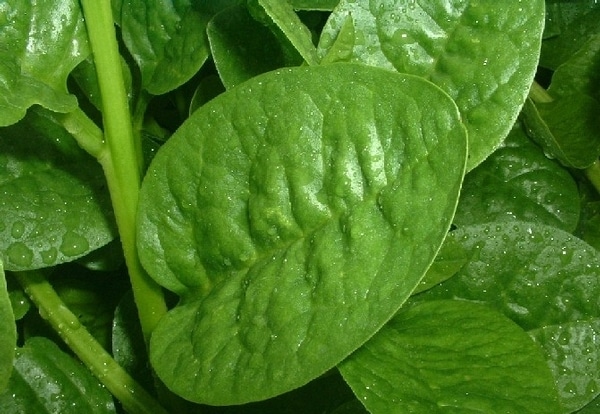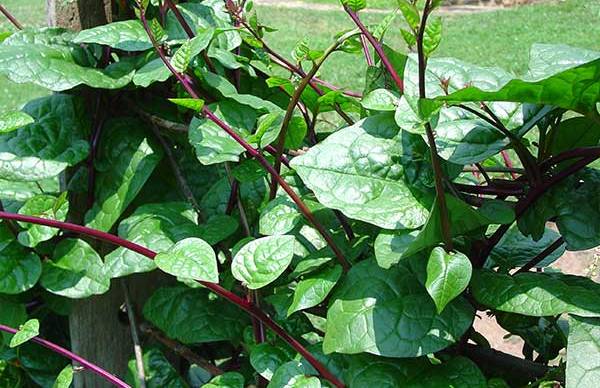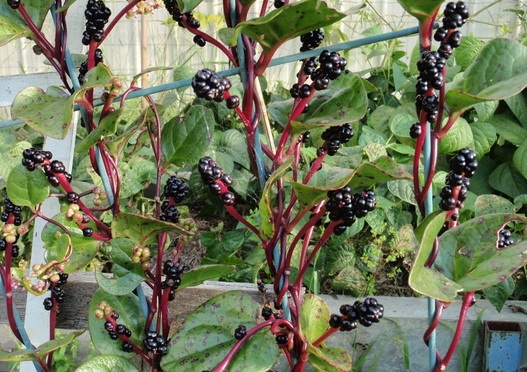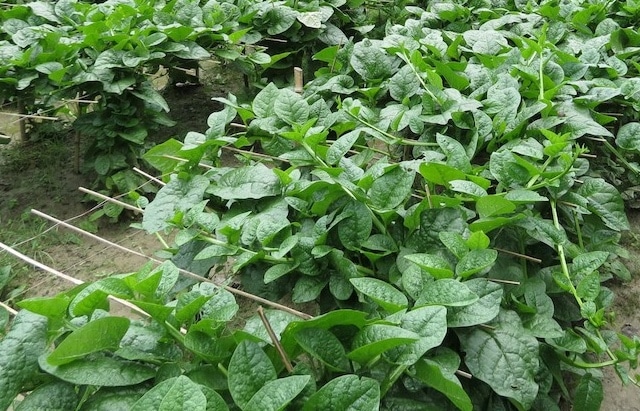Malabar Spinach Farming Guide:
Today, let us discuss the topic of Malabar spinach farming, planting method, plant care, harvesting, and other cultivation practices.

Introduction of Malabar Spinach:
Do not confuse yourself with regular spinach. Malabar spinach or Vine spinach or Basella or Climbing spinach is a popular tropical perennial highly nutritious heart-shaped leafy-green vegetable usually grown in many south Asian backyards. It is different from regular spinach. Malabar spinach is a creeping vine which produces the leaves of broad and deep green. This leafy vegetable is becoming popular especially in tropical and temperate climates of the world for its succulent, nutritious & tender stems. In India, this leafy vegetable used as fresh leaves in salads and curries. Malabar Spinach belongs to the family of Basellaceae and genus of Basella L.
Health benefits of Malabar Spinach:
The following are the health benefits of Malabar Spinach.
- Malabar spinach regulates and controls the blood pressure.
- Malabar spinach slows down the aging process.
- Malabar spinach is heart healthy.
- Malabar spinach helps in reducing bad cholesterol (LDL) and increases good cholesterol (HDL).
- Malabar spinach helps in constipation due its laxative properties.
- Malabar spinach helps in lowering the blood sugar level if taken daily in good amounts.
- Malabar spinach is good for lungs.
- Malabar spinach is good during pregnancy.
- Malabar spinach is a good source of vitamins A, B, & C, Calcium, Zinc, Magnesium, Phosphorous, Copper, Manganese & Iron.
Major Production States of Malabar Spinach:
Most of the states in India.
Common and Local Names of Malabar Spinach:
Malabar spinach, Indian spinach, Basella alba, Ceylon spinach, Climbing spinach, Vine spinach, Creeping spinach, Buffalo spinach (English), Poi, Safed bachla (Hindi),Pui shak (Bengali), Poi ni bhaji (Gujarati), Basale soppu (Kannada), Valchi bhaji or vauchi bhaji (Konkani), Vasalacheera (Malayalam), Mayalu (Marathi), Poi saaga(Oriya) Kodip pasali (Tamil), Bachhali (Telugu), Basale (Tulu).
Varieties of Malabar Spinach:
This leafy vegetable has two main cultivars.
- Basella alba, This variety produces green-stems and deep-green leaves.
- Basella rubra (red), This variety produces with reddish/purple-stems and deep-green leaves with pink/reddish veins.

Read: How To Identify Sick Rabbits.
Climate Requirement for Malabar Spinach Farming:
As the climate is concerned, it requires hot humid and moist conditions. It can be grown in partial shade conditions which increase the leaf size but it prefers hot humid and full sun exposures for best yield.
Soil Requirement for Malabar Spinach Farming:
Malabar spinach can be grown on a wide variety of soils. However, it prefers moist fertile soil with plenty of organic matter and soil pH should be 6.5 to 7.0.
Propagation of Malabar Spinach:
Propagation is done through seeds and vine cuttings.
Fully ripe seeds can be collected from the plant make them dry and use them in the next planting season. For better germination, soak them in water overnight the day before planting and it takes 3 weeks to germinate.
If the stems are too tough to eat when pruning, simply put them back into the soil where they start re-rooting.

Read: Lemon Grass Oil Extraction Process.
Land Preparation, Planting of Malabar Spinach:
Land should be given thorough ploughings to make the field weed free. Supplementing the soil with an organic matter will result in quality and good yield.

Weed Control:
Regular weeding should be carried out by removing dead leaves or diseased leaves. Weedicides can be applied to control the weeds.
Mulching:
Mulching is required to keep the plant base moist and preventing weed growth. Straw or hay can be used as mulch.
Irrigation requirements for Malabar Spinach
The plant requires consistent moisture to keep from flowering, which causes leaves to turn bitter and produce more leaves.
Read: Layer Birds Care and Management.
Pruning and Training of Malabar Spinach Vines:
As part of the pruning process, simply cut the thick, fleshy leaves while retaining some stem on the Malabar spinach plant. Cut back as you use it. For best yields, harvest continually. As a vine can reach up to 30 feet high, put on a trellis, wall or fence.
Manures and Fertilizers:
Add an appropriate amount of farmyard manure (FMY) along with nitrogen to keep producing leafy green foliage.
Harvesting of Leaves:
Harvest depending on the usage.
Yield in Malabar Spinach Leaves:
An average yield of 40 kg of Malabar spinach leaves from a ten-meter square bed can be obtained.
Read: Pregnant Goat Care.